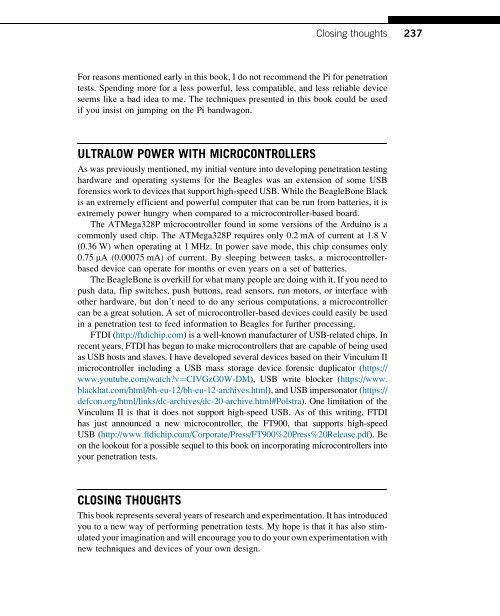Hacking_and_Penetration_Testing_with_Low_Power_Devices
You also want an ePaper? Increase the reach of your titles
YUMPU automatically turns print PDFs into web optimized ePapers that Google loves.
Closing thoughts<br />
237<br />
For reasons mentioned early in this book, I do not recommend the Pi for penetration<br />
tests. Spending more for a less powerful, less compatible, <strong>and</strong> less reliable device<br />
seems like a bad idea to me. The techniques presented in this book could be used<br />
if you insist on jumping on the Pi b<strong>and</strong>wagon.<br />
ULTRALOW POWER WITH MICROCONTROLLERS<br />
As was previously mentioned, my initial venture into developing penetration testing<br />
hardware <strong>and</strong> operating systems for the Beagles was an extension of some USB<br />
forensics work to devices that support high-speed USB. While the BeagleBone Black<br />
is an extremely efficient <strong>and</strong> powerful computer that can be run from batteries, it is<br />
extremely power hungry when compared to a microcontroller-based board.<br />
The ATMega328P microcontroller found in some versions of the Arduino is a<br />
commonly used chip. The ATMega328P requires only 0.2 mA of current at 1.8 V<br />
(0.36 W) when operating at 1 MHz. In power save mode, this chip consumes only<br />
0.75 mA (0.00075 mA) of current. By sleeping between tasks, a microcontrollerbased<br />
device can operate for months or even years on a set of batteries.<br />
The BeagleBone is overkill for what many people are doing <strong>with</strong> it. If you need to<br />
push data, flip switches, push buttons, read sensors, run motors, or interface <strong>with</strong><br />
other hardware, but don’t need to do any serious computations, a microcontroller<br />
can be a great solution. A set of microcontroller-based devices could easily be used<br />
in a penetration test to feed information to Beagles for further processing.<br />
FTDI (http://ftdichip.com) is a well-known manufacturer of USB-related chips. In<br />
recent years, FTDI has begun to make microcontrollers that are capable of being used<br />
as USB hosts <strong>and</strong> slaves. I have developed several devices based on their Vinculum II<br />
microcontroller including a USB mass storage device forensic duplicator (https://<br />
www.youtube.com/watch?v¼CIVGzG0W-DM), USB write blocker (https://www.<br />
blackhat.com/html/bh-eu-12/bh-eu-12-archives.html), <strong>and</strong> USB impersonator (https://<br />
defcon.org/html/links/dc-archives/dc-20-archive.html#Polstra). One limitation of the<br />
Vinculum II is that it does not support high-speed USB. As of this writing, FTDI<br />
has just announced a new microcontroller, the FT900, that supports high-speed<br />
USB (http://www.ftdichip.com/Corporate/Press/FT900%20Press%20Release.pdf). Be<br />
on the lookout for a possible sequel to this book on incorporating microcontrollers into<br />
your penetration tests.<br />
CLOSING THOUGHTS<br />
This book represents several years of research <strong>and</strong> experimentation. It has introduced<br />
you to a new way of performing penetration tests. My hope is that it has also stimulated<br />
your imagination <strong>and</strong> will encourage you to do your own experimentation <strong>with</strong><br />
new techniques <strong>and</strong> devices of your own design.


